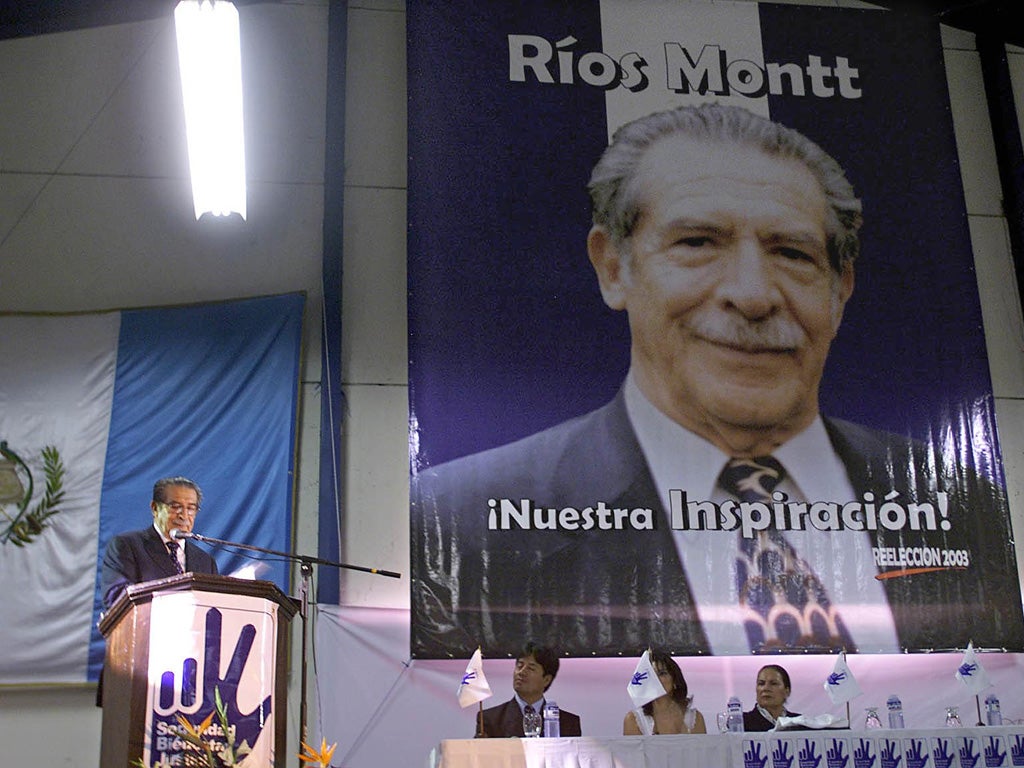The Ríos Montt genocide trial finally begins in Guatemala
His presence in the dock is a triumph in itself for the survivors and victims who have fought for so many years to face him in court

Tomorrow, General Efraín Ríos Montt, the former Guatemalan head of state, and his former head of military intelligence, General José Mauricio Rodríguez Sánchez, are due to stand in the dock of a Guatemala City courtroom to answer charges of genocide and crimes against humanity.
This day has been a long time coming: survivors and victims’ relatives have waited three decades for their questions to be answered about one of the bloodiest periods in Guatemala’s recent history.
Almost 31 years ago to the day, Ríos Montt seized power in a military coup. The country was already in the midst of a conflict that had cost thousands of lives, but 1982 proved to be the year in which almost half of the torture, massacres, rapes, and enforced disappearances committed during the entire conflict took place, according to the UN-backed truth commission set up at the end of the war.
The precise charges against Ríos Montt and Rodríguez Sánchez relate to the killings of 1,771 individuals and the forced displacement of tens of thousands from the Ixil triangle region of southern Quiché. The prosecution alleges that they bore command responsibility for the crimes which occurred. The allegations are based on exhumation records from mass grave sites, witness testimonies and a plethora of military files which the military suppressed for years.
Some of the incidents presented in the charge sheet are horrific. In 1982, soldiers arrived at the house of Magdalena Matom Raymundo, asking for her husband. As he was not to be found, his pregnant wife was tortured and raped, and the house burned down.
Amnesty International’s own reports from the period are full of the horror that swept over the Guatemalan countryside under Ríos Montt’s rule. In a July 1982 report, Amnesty’s researchers wrote: “In one of the villages the army reportedly forced the entire population into the courthouse, raped the women, beheaded the men and battered the children to death against rocks in a nearby river”.
Yet justice for these crimes has been slow in coming. A 1999 UN-backed truth commission found that during Guatemala’s 36-year internal armed conflict (1960-1996) some 200,000 people were killed or disappeared, and countless victims were raped and tortured. After documenting more than 600 massacres, the commission concluded that genocide against the Mayan people had occurred. To date, almost all of those suspected of criminal responsibility for the crimes of the conflict years have evaded justice.
Thanks to the dogged determination of survivors and Guatemalan NGOs, there have been some significant breakthroughs in recent years. The Attorney General’s Office has managed to secure convictions in several historic massacre and disappearance cases. However, the accused have generally been low-ranking officers and soldiers, which makes the trial of Ríos Montt a true watershed moment.
The trial will inevitably generate wider questions about the way Guatemala has dealt with its recent history. Among the most important will concern the military’s continuing attempts to conceal the truth about its past operations. It has steadfastly refused to make documents from the period 1980-85 available - the period when the vast majority of human rights violations were committed.
In other areas, progress in addressing the traumas of the past has also been slow or inexistent. A bill to create a National Commission to Search for Victims of Enforced and Other Forms of Disappearance was tabled in 2007, but to date, Congress has failed to pass it into law.
Of similarly deep concern at the moment is the fact that the truth commission’s finding of genocide is being repeatedly denied by influential figures. Guatemalan President Otto Pérez Molina has consistently stated that genocide never occurred, even declaring so publicly the day after Ríos Montt was formally linked to the genocide case in January 2012.
Ríos Montt’s presence in the dock is a triumph in itself for the survivors and victims who have fought for so many years to face him in court. As one survivor told Amnesty after the initial decision to link Ríos Montt to the genocide case last January:
“When we were in the court building, we felt courageous because we had come face to face with Ríos Montt. For me it was an achievement and a victory because this is historic for a Maya person, for the Maya. Being in court, face to face with this soldier, who was untouchable before… It is our hope that he will go to prison – even if only for five days – because then it will go down in writing that General Efraín Ríos Montt was sent to prison for the crime of genocide.”
It is to be hoped that this trial will serve as a milestone, showing that no-one is above the law; and that in Guatemala, as elsewhere in the Americas, the tide of impunity for past human rights violations continues to turn.

Join our commenting forum
Join thought-provoking conversations, follow other Independent readers and see their replies